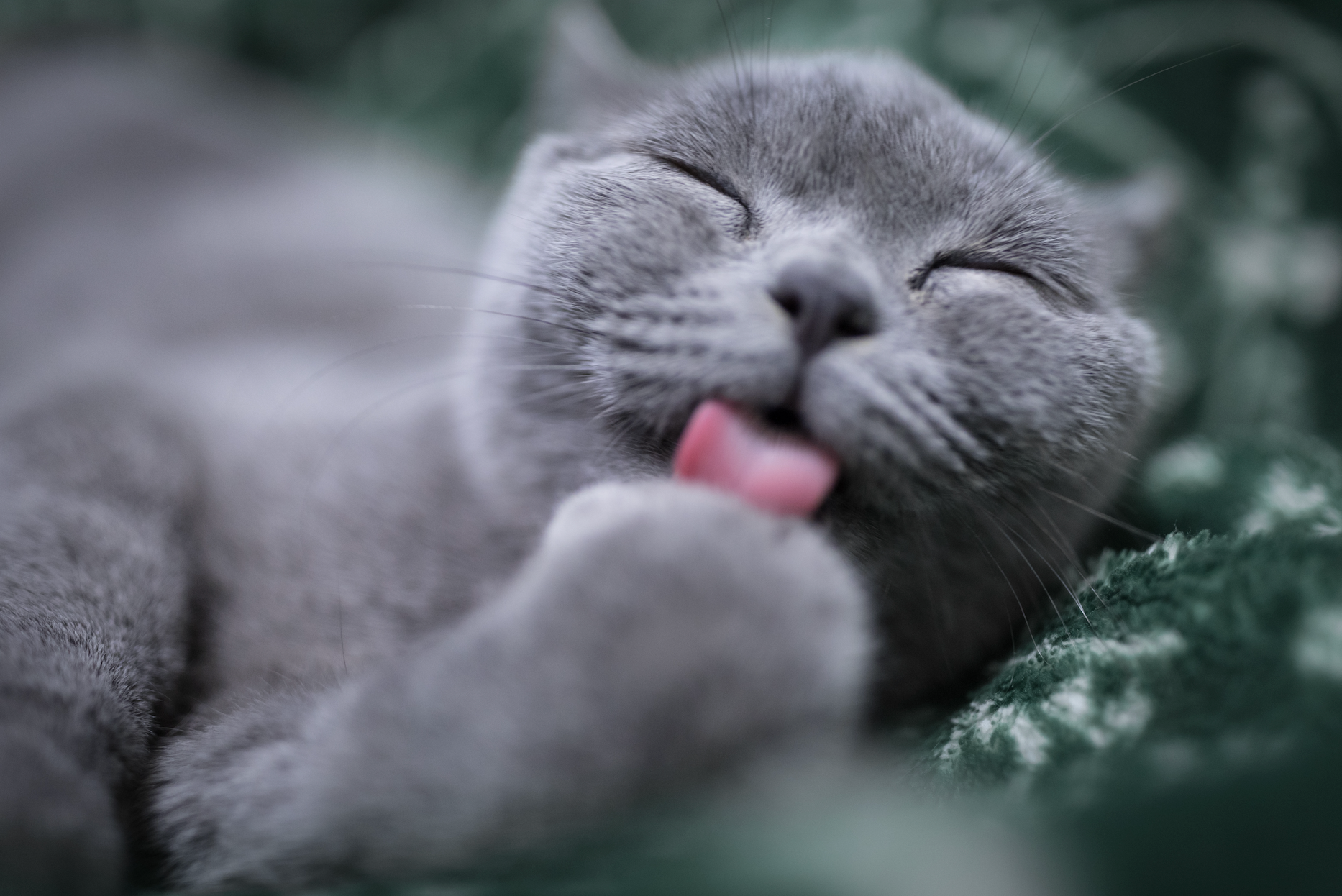Making Sense of Overgrooming in Cats
June 26, 2023

Overgrooming in cats, also known as psychogenic alopecia, is a behavior characterized by excessive licking, chewing, or scratching, leading to hair loss and potential skin damage. This common but often misunderstood condition can stem from various underlying issues, ranging from medical problems to emotional distress.
Recognizing and addressing overgrooming early can significantly improve your feline friend's overall health. And, if your cat isn’t overgrooming, prevention should be considered to maintain your cat’s well-being.
Why is My Cat Overgrooming?
Overgrooming is not a condition on its own, but rather a symptom of a possible underlying issue. Cats are meticulous groomers by nature, and grooming serves as a self-soothing mechanism.
However, when grooming turns excessive, it's a clear indication that something is amiss.
But what's wrong? Here’s a list of potential causes for your cat’s unusual behavior:
- Allergies: Cats can develop allergies to certain foods, environmental factors, or substances they come into contact with. Allergic reactions often cause itchiness, leading to excessive grooming.
- Parasites: Fleas, mites, or other skin parasites can cause severe itching, prompting a cat to overgroom in an attempt to relieve the discomfort.
- Skin Disorders: Conditions such as dermatitis or fungal infections can cause discomfort or itching, leading to overgrooming.
- Pain: Cats might overgroom a specific area of the body due to underlying pain or discomfort, which can be a sign of issues such as arthritis, urinary tract infections, or dental problems.
- Psychological Stress: Cats are sensitive to changes in their environment. Stressors such as moving house, a new pet or family member, or changes in routine can cause anxiety, which cats may respond to by overgrooming.
- Boredom: Lack of mental and physical stimulation can lead to boredom, which in turn can lead to overgrooming as a form of self-soothing or to fill the time.
- Hormonal Imbalance: Certain hormonal conditions, such as hyperthyroidism, can lead to behavioral changes, including overgrooming.
Signs of Overgrooming in Cats
Identifying overgrooming can be challenging due to cats' private nature and their innate grooming habits. The key lies in spotting changes in your cat's grooming behavior and physical appearance.
Be on the lookout for the following signs:
- Bald Patches: One of the most obvious signs of overgrooming is bald patches on your cat's body. This is often a result of your cat licking, biting, or scratching the same spot repeatedly. Your cat’s coat should appear shiny and full. It shouldn’t be dull or missing patches of fur.
- Hairballs: While all cats produce hairballs to some extent, excessive hairballs can be a sign of overgrooming, as the cat is ingesting more hair than usual.
- Skin Sores or Infections: Overgrooming can lead to self-inflicted wounds or sores on the skin due to excessive licking, biting, or scratching. These areas can also become infected if left untreated.
- Changes in Behavior: Changes in your cat's grooming habits may suggest overgrooming. This could mean your cat is grooming more often than usual, or grooming seems to have become a compulsive behavior.
- Thinning Fur: If your cat's fur seems thinner than usual, it could be a sign they’re grooming too frequently.
- Irritated Skin: Overgroomed areas may appear red, inflamed, or irritated.
- Anxiety or Restlessness: Overgrooming can sometimes be a response to stress or anxiety. If your cat appears more anxious or restless than usual, they may be overgrooming as a coping mechanism.
How to Stop Overgrooming in Cats
Once you recognize signs of overgrooming in cats, the next step is to consult a vet. They can perform a thorough examination to rule out medical conditions or identify underlying issues that could be causing the behavior.
The following changes may be suggested, by your holistic or traditional veterinarian, in an attempt to get their grooming habits under control:
- Medical Treatment: If a medical condition like allergies or parasites is causing the overgrooming, your vet will provide the appropriate treatment. This could be anything from medication to dietary changes.
- Environmental Changes: If the overgrooming is stress-related, it's essential to identify the stressors and minimize them. This could involve changes to your cat's environment, like adding more hiding spots, providing more interactive toys, or reducing loud noises.
- Behavioral Therapy: In some cases, a vet might recommend a behaviorist to work with your cat. They can help provide targeted strategies to reduce stress and anxiety.
- Medication: For severe cases, your vet might prescribe medication to manage the anxiety leading to overgrooming.
The prevention of overgrooming primarily involves maintaining a stable, stress-free environment for your cat. Regular veterinary check-ups are crucial for the early detection of potential health issues. Additionally, providing your cat with plenty of mental and physical stimulation can also help reduce stress, minimizing the chances of overgrooming.
Probiotics Can Manage or Prevent Overgrooming
Probiotics, like those found in Daily Cat, have been gaining attention in both human and animal health for their potential benefits, including their role in managing or preventing overgrooming in cats. Here's how they can help:
- Boosting the immune system: Probiotics contribute to a healthy gut microbiome, which is linked to improved immune system functioning. A strong immune system can help a cat better combat skin infections and allergies.
- Reducing allergies: Probiotics can help regulate the body's immune response and decrease inflammation, potentially reducing allergic reactions. Since allergies often lead to itchiness that may cause overgrooming, reducing these allergic reactions can mitigate overgrooming.
- Improving digestive health: Overgrooming can sometimes be a response to gastrointestinal discomfort. By promoting a healthy digestive system, probiotics can help alleviate such discomfort and indirectly prevent overgrooming.
- Stress management: Some research suggests that there is a strong connection between gut health and mood, known as the gut-brain axis. A healthy gut microbiome may contribute to better mood and stress management, which could be beneficial for cats prone to stress-induced overgrooming.
- Skin health: Certain probiotics are known to promote healthy skin. By strengthening the skin's barrier and reducing inflammation, probiotics may reduce itchiness and discomfort that could trigger overgrooming.
A Significant Concern
Overgrooming in cats is a significant concern that requires prompt attention and understanding. As a pet parent, recognizing the signs and seeking professional help can make a world of difference to your feline friend's health and happiness.
Remember, a content cat isn't just a well-fed or well-groomed cat; it's a cat that feels secure, loved, and mentally stimulated in its environment. By catering to these needs, we can help mitigate issues like overgrooming, leading to happier, healthier feline companions.
Read More:
Probiotics and the Microbiota-Gut-Brain Axis: Focus on Psychiatry
Saccharomyces boulardii Probiotic for Pets
Effect of a Multistrain Probiotic on Feline Gut Health
Microbiota and Probiotics in Canine and Feline Welfare

